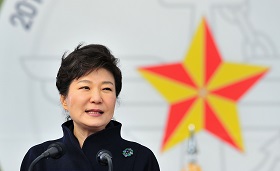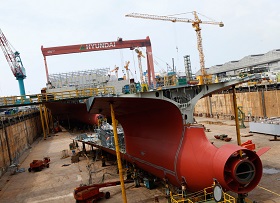South Korean Navy and Worthy Descendants of Yi Sun-shin
The largest ship of the South Korean navy,
the Dokdo-class amphibious assault carrier
In
Login if you are already registered
(no votes) |
(0 votes) |
PhD in Political Science, RIAC expert
The Republic of Korea’s navy is a modern and efficient instrument of foreign policy pursued by Seoul, and in the longer term its role will only continue to grow, whatever the changes in South Korean foreign policy. In 2013, James R. Holmes, one of the most prominent US experts on naval capabilities in Asia Pacific, praised the Republic of Korea’s navy as the best in Asia Pacific in terms of “its capacity to execute the missions national leaders entrust to it”.
Reviving Past Legacies
Korea's naval traditions are over one and a half thousand years old: back in the 4th century A.D. King Gwanggaeto the Great, the ruler of Goguryeo, one of the three Korean Kingdoms, occupied the kingdom of Baekje thanks to the skilful use of his fleet. One of the greatest national heroes of Korea is naval commander Yi Sun-shin (1545-1598), renowned for his victories in the Imjin Wars against Japan (1592-1598). Yi Sun-shin became famous in particular due to his heroic victory in the Battle of Myeongnyang (1597), when he defeated a large Japanese fleet (about 130 vessels) with just 13 boats. He is also celebrated for his victory in the Battle of Noryang Point (1598), which cost him his life, when about 150 Korean and Chinese vessels defeated the fleet of about 500 boats, according to Korean sources, carrying the retreating Japanese army home.
Despite its glamorous past, the current Republic of Korea’s navy is fairly young. The Association of Naval Affairs of Korea was established on 11 November 1945, with Sohn Won Il at the head. This entity became the Korean Coastal Guard and subsequently, on 15 August 1948, the South Korean Navy. Sohn Won Il became the first ever Chief of Staff of the Navy.
However, the first Korean fleet was capable only of providing for the country's coastal defence. It had two second-hand, 1,500-ton US patrol frigates with a total strength of the Korean navy personnel (not including the Marines) of around 7,000.
The geopolitical position of Korea and its immediate proximity to hostile North Korea make it imperative to sustain a substantial and battle-worthy fleet in coastal and close-range offshore zones. In contrast to Japan or Australia, Korea has had to concentrate on building offshore vessels.
In the 1950s – 1980s, the chief objective of the country's navy was to protect the coast against the North Koreans. The coastal fleet grew, but it was still built around second-hand US vessels. By 1980, the number of naval personnel had grown to 20,000. In the 1970s, the government of Part Chong-Hee set out to boost the growth of the local Korean defence industry. A number of important ship-building projects were launched, including Ulsan-class frigates and Pohang-class corvettes.
In the 1990s, the South Korean navy continued to develop. In particular, its own submarine fleet was established when Korea procured German-designed submarines. The first of them, a member of the Chang Bogo class commissioned in 1993, was built in Germany. The second and third submarines were built, in part, in Korea, while the fourth one was built completely in Korea. Korean firms also actively built surface craft. And while their numbers dropped, the level of naval sophistication and capabilities was on the rise. By 2000, naval personnel had reached 40,000.
By the late 1990s, Korea launched its blue-navy project. Without a doubt, the geopolitical position of Korea and its immediate proximity to hostile North Korea make it imperative to sustain a substantial and battle-worthy fleet in coastal and close-range offshore zones. In contrast to Japan or Australia, Korea has had to concentrate on building offshore vessels.
However, advanced industries, focused government policies and US support will not be key to the future of the Korean navy. Its main pillar is its fleet of highly disciplined, highly motivated and excellently trained seamen.
The Korean «Island»
Throughout the 2000s, the Republic of Korea successfully completed a range of ambitious ship-building projects aiming at establishing a relatively small, but modern and battle-worthy blue-navy fleet. With virtually the same number of personnel, the level of naval craft sophistication was constantly increasing. The reason lay partly in the slight reduction of the threat posed by North Korea, which lost some of its strength compared to South Korea. However, the main reason for the emergence of blue-navy ambitions was the growing dependence of South Korea on maritime trade and hydrocarbon imports.
In September 2013, speaking at the ceremony commemorating the 60th anniversary of the South Korean Coastal Guard, Park Geun-hye, President of the Republic of Korea, painted a clear picture explaining the need for stronger maritime capabilities in her country. According to President Park Geun-hye, the Republic of Korea, as a country practically cut-off from the rest of the world by land due to hostile North Korea, is virtually an «island», and South Korea needs its naval status because of its complete dependence on sea trade.
The Republic of Korea, as a country practically cut-off from the rest of the world by land due to hostile North Korea, is virtually an «island», and South Korea needs its naval status because of its complete dependence on sea trade.
The focus on naval capabilities is also demonstrated by the fact that it was an admiral, Choi Yoon-Hee, who was appointed Chairman of the Joint Chiefs of Staff in October 2013 for the first time ever in history. This is all the more remarkable since the navy is still the smallest armed service numerically in South Korea: there are slightly more than 40,000 personnel (however, the number is much larger if you include the 28,000 Marines), whereas the air force has 65,000 and the army, 522,000.
The current naval strategy in South Korea is well described by the reference to what Lee Chung Cun, from the Korean Institute of Economic Studies, said: “Given our limited financial resources, it is true that we cannot build a navy capable of engaging in combat and winning a sea battle with China or Japan. But we can build a fleet that is capable of denying other countries’ attempts to block Korea's sea lines”. Admiral Chon Yoon-Hee insists: “We need the capability of deterring North Korea, and at the same time we need the minimum capacity to respond to possible threats coming from neighbouring states.” The ocean-going fleet was created because there was a need, on the one hand, to protect sea lines, and, on the other, to ensure reasonable capabilities to deter China and Japan.
Despite booming economic ties between China and South Korea (suffice it to say that between 1993 and 2013, trade between the two countries rose from US$ 9 bln to US$ 229 bln, Seoul and Beijing have had a number of rather strong disagreements. South Korea and China have held long disputes over the delimitation of their exclusive economic zones (EEZ) in the East China Sea and in the Yellow Sea. In December 2013, South Korea extended its air defence identification zone in response to a similar move by China earlier, in November 2013. Although the South Korean zone was established in the wake of China’s establishment of its own zone, China nevertheless expressed its “regrets” over Seoul's action.
There was certainly publicity attached to the issue of the submerged Ieodo Rock (known in China as the Suyan Rock and also known as Sokotra Rock) at the intersection of the Chinese and Korean EEZs. In 2003, Koreans set up a research station there which made China unhappy. Although Ieodo is much closer to South Korea than to China (it is 149 km from the Korean Island of Marado, and 247 km from China's Tongdao), and, according to the official position of the Chinese foreign office, “there are no territorial disputes around the underwater Suyan Rock which is an isolated submerged rock and is not part of the sovereign territory”, relations between Beijing and Seoul on issues of the delimitation of marine borders remain rather tense.
Its major ship-building projects have been a form of government support for domestic ship-builders who suffered a setback as a result of the global economic crisis and the strong competition from China.
Finally, another source of tension between South Korea and China has been illegal fishing by Chinese fishermen in Korean waters. In 2010, when a Chinese trawler collided with a South Korean Coast Guard patrol boat, and the Chinese fishing boat capsized and sank, one fisherman drowned and two more went missing. In 2011, a detained Chinese fisherman assaulted two Korean Coast Guard officers with a knife, killing one of them. A Korean court sentenced him to 30 years in prison, and the Chinese, who actively supported their fishermen, routinely criticised such «unilateral» acts by Korea.
Despite the bilateral treaties governing a military alliance that both South Korea and Japan have with the US, and growing economic links (trade between Korea and Japan in 1993-2013 grew from US$ 31.6 bln to US$ 94.7 bln), their relations are also far from perfect. Korean society and the political elite still have strong memories of the national humiliation they suffered as a result of the Japanese occupation in the first half of the 20th century. Many South Korean ships carry the names of Korean independence fighters.

South Korean and U.S. Navy admirals inspecting
the wreckage of the Cheonan, September, 13
2010
The largest ship of the South Korean navy, the Dokdo-class amphibious assault carrier, is named after a group of islands in the Sea of Japan (which in Korea they prefer to call the Eastern Sea, alleging that the name of the Sea of Japan was “imposed” by Japan): the islands under the South Korean jurisdiction are the cause of a territorial dispute with Japan. The issue of the Dokdo Islands (which are known as the Takeshima Islands in Japan, and are also called the Liancourt Rocks) is not about a few dozen tiny islets that barely cover an area of 0.2 square km, but rather about almost 57,000 km2 of fish-rich EEZ, which may also contain up to 600 mln tons of natural gas hydrate.
South Korea is also eager to become more prominent in the global system of maritime trade, international security and international cooperation in the naval sphere. In 2009, South Korea joined the counterpiracy efforts in the Gulf of Aden (with its Cheonghae Unit consisting of a destroyer, a military helicopter and about 300 troops), and the Proliferation Security Initiative. The South Korean navy took part in peacekeeping and humanitarian missions. South Korea has been cooperating with the US and Japan in ballistic missile defence. The existing and the new Korean KDX-III destroyers may be gaining the BMD capabilities similar to those of US and Japanese ships.
The 1990s strategy to establish a blue-water navy notwithstanding, the situation in the Korean Peninsula remains tense, particularly around the disputed “Northern Limit Line” and “the five Yellow Sea islands”: Baekryeong-do, Daecheong-doe, Socheong-do, Yeonpyeong-do, and Woo-do. These were the target of numerous high-profile confrontations between North and South Korea in the most recent history: naval clashes at Yeonpyeong-do Island in 1999 and 2002, a clash at Daecheong-doe in 2009, the ROKS Cheonan sinking and the shelling of Yeonpyeong-do Island in 2010 are enough evidence of the persistent need to maintain a battle-worthy coastal fleet, which somewhat constrains South Korean oceanic ambitions.
Navy Development
Below we list the vessels that make up the bulwark of today’s Korean Navy:
- 1 Dokdo amphibious assault carrier, with almost 19,000 tons of full-load displacement;
- 12 destroyers, including three Aegis KDX-III destroyers with an automated battle management system (King Sejong the Great-class destroyers), about 11,000 tons of full-load displacement;
- 10 frigates, including one FFX Incheon Class frigate, over 3,000 tons of full-load displacement;
- 21 Pohang Class ships (sister ships of the sunk ROKS Cheonan);
- 9 Chang Bog-class conventional submarines of the Type 209 German submarine design, and three Son Wonil-class Type 214 conventional submarines;
- 3 Cheonji-class Fast Combat Support Ships, about 9,000 tons of full-load displacement.
Future naval development is based on plans to build the following ships:
- 3 KDX-III destroyers by 2023;
- 6 new KDDX 5,600 tons destroyers, with the Aegis combat system, some time after 2023;
- 6 Son Wonil-class diesel submarines by 2023;
- 9 large KSS-III conventional submarines with a Korean design and a displacement of about 3,000 tons, armed with land-attack cruise missiles, after 2023;
- Up to 25 FFX frigates to replace older corvettes and frigates, before 2026;
- Several AOE-II fast combat support ships with a displacement of 12,000 tons to replace the Cheonji-class ships.
According to some sources, South Korea has been entertaining plans to develop its aircraft carrier component as well. There have been talks about installing a ski ramp on a Dokdo-class LPH or building a larger amphibious assault craft with a ski ramp, similar to the Spanish Navy’s Juan Carlos, before 2019, or two 30,000-ton light aircraft carriers similar to the Italian carrier Cavour, before 2036.
In addition, the Korean fleet has over 80 small patrol boats. So far, the PKX programme has pursued plans to build 500-ton PKG-A and 200-ton PKG-B boats to replace more than 70 older, 170-ton Chamsuri-class patrol vessels. The plan is to build about 18 PKG-A and PKG-B boats.
Another important area of development has been the capabilities of land-based patrol naval aircraft. Believing that the country was perilously short of patrol airplanes, South Korea doubled their number, deploying by 2010 eight more P-3CK aircraft to add to eight P-3C Orion Maritime Patrol Aircraft. By 2013, South Korea has approved procurement plans for 20 new patrol aircraft, and started upgrading the eight existing P-3C aircraft to P-3CK. With regards to helicopters, apart from 11 Lynx and 12 SuperLynx helicopters, Korea has started to deploy eight Wildcats and 30 Surion helicopters. Patrol vessels, land-based patrol aircraft and helicopters, together with mine-sweeper support ships, form the basis of the South Korean coastal capability.
The success of the South Korea’s ship-building programmes lies in its highly advanced ship-building industry as well as in close military and technical cooperation with the US. Its major ship-building projects have been a form of government support for domestic ship-builders who suffered a setback as a result of the global economic crisis and the strong competition from China. Ship-building projects help to offset the lack of business on the civilian side as well as to stimulate technological development. In future they could promote South Korea to the role of an active exporter of naval equipment.
However, submarines are even more important for Korean industry. In the 2020s, South Korea plans to design and build large advanced conventional submarines. There are two South Korean corporations with experience in submarine-building: DSME and Hyundai Heavy Industries. As part of its military technical cooperation, South Korea has already begun implementing projects for the construction of three Chang Bog-class submarines and technology transfer in the interests of the Indonesian navy. Putting the fourth Son Wonil-class sub to water, the South Korean President, Park Geun-hye, declared: “The Kim Jwa-jin submarine will not only contribute greatly to safeguarding our maritime sovereignty, but also become a symbol for promoting our country’s defence science and technology.”
South Korea continues to strengthen its armed forces and defence industries. And while its alliance with the US has played, and will continue to play, a key role in South Korean defence strategy, its military policy and armed forces development will become more independent. The issue of the transition of the wartime operational control over the South Korean armed forces to the Republic of Korea will be resolved some time in future (at the moment it is provided by the Combined Forces Command headed by a four-star US general), even if this process is not completed by December 2015, as was planned originally.
The Republic of Korea’s navy is a modern and efficient instrument of foreign policy pursued by Seoul, and in the longer term its role will only continue to grow, whatever the changes in South Korean foreign policy. One of the chief challenges will be to strike an appropriate balance between the coastal fleet and a blue-water navy, surface and submarine fleets, marine aircraft and naval ships. In 2013, James R. Holmes, a professor of strategy at the U.S. Naval War College and one of the most prominent US experts on naval capabilities in Asia Pacific, praised the Republic of Korea’s navy as the best in Asia Pacific in terms of “its capacity to execute the missions national leaders entrust to it).
Despite a number of crucial distinctions in the geopolitical position of the countries, Russia is well advised to learn from the South Korean experience applicable to its policies in the region. Consistent and steady strengthening of the Russian Pacific fleet, balancing of its coastal and blue-water components, promoting the right amount of economic and human resources capabilities for independent growth, boosting the regional cluster of defence and industries are the key prerequisites for ensuring national security in the region.
(no votes) |
(0 votes) |







